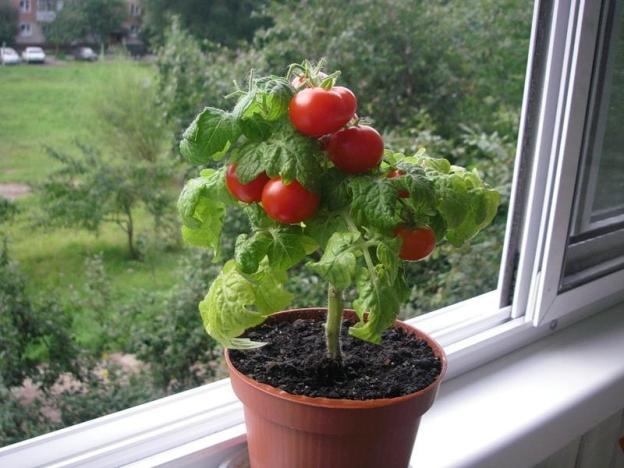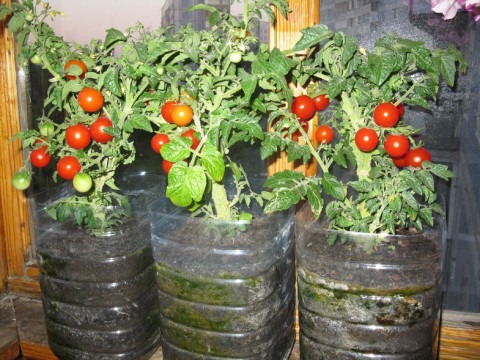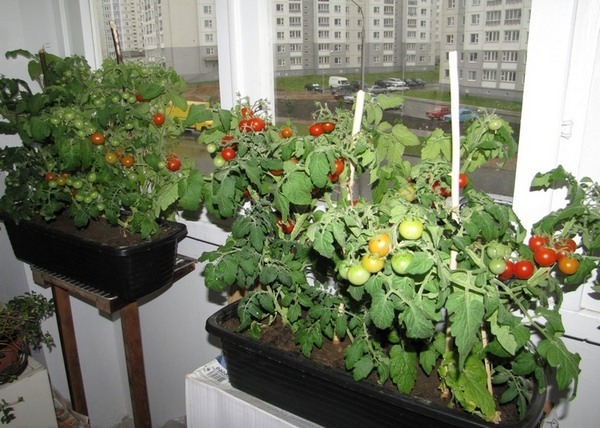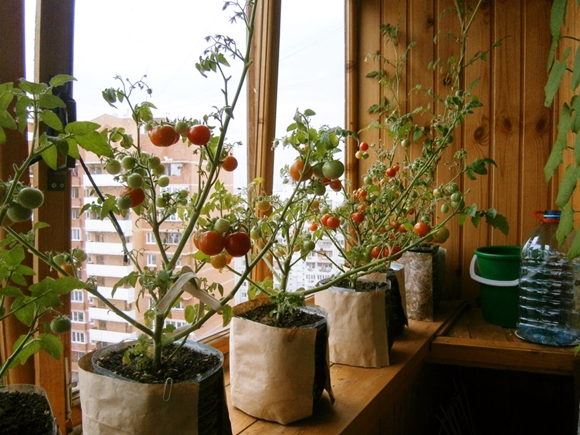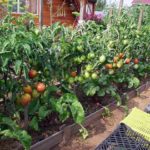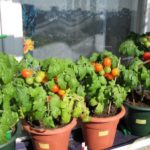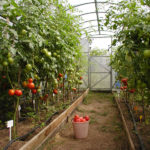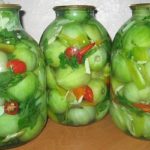How often to water tomato seedlings on the windowsill is an important question that worries gardeners. Watering is an important step in plant care. It is through water that the bushes receive all their nutrients.
First steps
Many people want to have a fresh harvest of vegetables for the table, even in winter. Others do not have the opportunity to grow a plant in the garden themselves, even in summer. Therefore, the question may arise about how to grow tomatoes on a windowsill.
To grow tomatoes in an apartment, you need to invest patience, diligence and perseverance. In this case, a high-quality fresh harvest will delight you on the windowsill all year round.If you want to collect fruits in winter and spring, it is better to plant in November. To continue harvesting in the summer, seeds are planted in the spring (it is better to sow at the end of March).
Growing tomatoes at home begins with the correct selection of varieties. It is better to choose low-growing and standard (having a strong stem and compactly located branches) types of tomatoes for growing on a windowsill.
They take up little space, they do not need large containers, they can produce a rich harvest, there is no need to install a support and artificially pollinate.
Seeds also need special care. Only large seeds are selected from the pack, which are then necessarily disinfected. This will prevent the formation of a fungal infection in the future. You can keep the seeds for 5 hours in a weak solution of potassium permanganate.
A solution of potassium permanganate only prevents the development of diseases, but does not in any way affect the quality of growth. To stimulate growth, it is recommended to use special preparations.
An important point on how to grow tomatoes at home is preparing the soil. It's better to buy soil in a store. It is not recommended to take ordinary soil from the garden, since there is almost always a source of infection there. You can prepare the soil yourself. A good mixture is obtained from wood soil, humus, compost and sand.
Suitable varieties
To grow tomatoes in winter, you need to choose the right varieties and know how to properly care for them. It is best to choose varieties with early ripening, self-pollinating, and resistant to various diseases (a closed loggia or balcony is characterized by humid air and the frequent development of fungal diseases).
You should also choose tomatoes for the windowsill, which do not have a very pronounced root system to fit in a pot or cache-pot.
When choosing a variety, it is not necessary to take weather conditions into account. But the length of daylight hours matters, since plants especially need lighting. For example, in Ukraine the weather allows for growing tomatoes, not only at home. Vegetable growers have been planting varieties such as “Ballerina” and “Pink Honey” for many years.
What varieties of tomatoes are most suitable for the balcony? The following best varieties are very popular for breeding: “Room Surprise”, “Balcony Bonsai”, “Balcony Miracle”, “Butterfly”, “Angelica”. The technology for growing domestic cultivated plants has similar stages.
Tomato varieties such as “Malyutka”, “Belyi Naliv”, “Zelenushka”, “Little Red Riding Hood”, “Thumbelina” are also popular. At home, indoor tomatoes of these varieties do not exceed 45 cm in height and fit a lot of fruit on a branch.
You can try growing tall varieties of tomatoes. Among tall species, the Cherry variety is common. The small size of the fruit will please you in any season.
Tall and medium-sized tomatoes on the windowsill in an apartment need pinching and bush formation. It is better to leave two or one stem.
Secrets for further care
There are many nuances to how to grow tomatoes at home. In a prepared container with moist soil, seeds are sown in shallow holes (no deeper than 1 cm) at a distance of 1.5 cm. For convenience, you can take a stick with a mark and make holes in which the seeds are sown. Then sprinkle with earth. After all the seeds have been planted, water the soil through a strainer and cover with glass or polyethylene film.
An important rule on how to grow tomato seedlings is choosing its location. Heating devices are always located near the windowsill to dry the soil. Therefore, this place is not suitable for germinating seeds. You need to water the soil using a watering can as it dries.
After a week, the first shoots should be observed. Begin to ventilate the container with the sprouts, and the soil should be constantly moist. Watering is carried out early in the morning with settled water. You can empty the container from the bag when 90% of the sown seeds have sprouted.
Tomato seedlings on the windowsill must be constantly turned with different sides to the window. This helps the stems grow even and strong. If tomatoes grow on one side, they bend, stretch and develop poorly.
Growing tomatoes on a windowsill is not complete without picking. As soon as the first leaves develop, the bushes are transplanted into separate plastic cups, pricked (pinching off the long ends of the root) and the first fertilizing with microelements is applied. Only those that have grown larger and stronger should be transplanted into separate containers, while the rest can be left to grow in a common container.
It is necessary to make holes at the bottom of plastic cups through which excess liquid will escape and fungal diseases will not develop.
Picking is necessary to make a small root system branchy. When picking, it is important not to damage the small roots of the seedling and replant it along with the soil that the roots have covered. From this moment on, fertilizing is applied every 12 days.
To grow indoor tomatoes, you need to water them properly and loosen the soil over the next few days. You need to water at the root, with little pressure, otherwise the roots will be exposed.Water should not get on the leaves and stems. In sunny weather, watering should be done in the evening.
After picking, you can immediately transplant the seedling into a permanent large pot or use cups for a while. In the latter option, it is necessary to replant into large containers when the roots of the plant envelop the entire soil in the glass. The ideal option is a bucket of about 10 liters; for the Cherry variety, a pot with a capacity of 3 liters is also suitable.
Once the potted plants have adapted and taken root, fertilizing can be applied (approximately 12 days after transplanting).
Further courtship
There are other rules for growing tomatoes on a window. After the tomatoes are in their permanent place, they need additional care.
To grow tomatoes on your windowsill in winter, you need care and special conditions. Small bushes are afraid of drafts and watering with cold water. The water temperature intended for irrigation should be approximately 22 degrees. Do not overdo it with water; constantly wet soil becomes a source for the development of diseases.
You need to pour water near the bush, and after moistening, be sure to loosen the soil to reduce evaporation. Loosening should be done carefully, without damaging the roots. Hilling can also be carried out at the same time, as this helps strengthen and develop the root system.
Growing tomatoes on a windowsill is not complete without regular fertilization. The following recipe is popular. A little superphosphate, potassium sulfate and urea are added to a liter of water. You can use mullein or chicken droppings.
After the seedlings have been grown, additional feeding must be carried out during the period of rapid color, formation of ovaries and during fruiting.
If tall and medium-sized varieties were selected for growing tomatoes on a windowsill from seeds, then additional stems (stepchildren) will form on the bushes. It is necessary to carry out pinching to improve the nutrition of the fruit.
As the plant develops at home in a pot, dry leaves are removed, especially those located close to the root. Dried leaves prevent moisture from reaching the roots.
The appearance of tomatoes
From the moment the ovaries appear, further care of cultivated plants is required. Homemade tomato bushes do not require artificial pollination. But to improve the process of formation of ovaries, it is recommended to slightly shake the stem every 4 days during the flowering period. This way pollen from the top flowers will fall onto the bottom row.
Some experienced gardeners use another method that allows fruits to mature faster on the windowsill in winter. For this purpose, the bush is taken at the base and carefully pulled up. During this procedure, small roots are torn off, which take away nutrients. Then it is recommended to water the plant and hill it up.
It is useful to feed tomatoes on the windowsill during the formation of ovaries by foliar feeding. You can dilute 1 g of boric acid in a liter of water.
If the bushes are tall, then it is necessary to fix the branches at the support, otherwise they may break under the weight of the tomatoes.
You should not leave tomatoes on the bushes until they are fully ripe. They are collected unripe.
Facing problems
Not everyone can grow tomatoes without problems at home.Very often, especially novice gardeners, are faced with the problem of plants withering and leaves turning yellow. There are several explanations for why tomato seedlings wither:
- increased indoor humidity or excessive watering of the soil;
- presence of drafts in the room;
- a large number of fertilizers, especially those containing nitrogen;
- cold air or cold water for irrigation;
- lack of space for plant development;
- lack of lighting or prolonged exposure of the plant to the sun;
- diseases and insect pests;
- lack of useful components in the soil.
Therefore, homemade tomatoes are not placed near opening windows, the gap between the bushes should be at least 2 cm, and fertilizers are applied no more than once a week. Be sure to monitor humidity and room temperature.
When bushes turn yellow and dry out, the reason may lie in disease. If the consequences of improper plant care can be quickly eliminated, for example, by placing seedlings in another place, replanting or removing wet soil, then saving the crop from diseases becomes more difficult.
The cause of disease is most often poor-quality soil (even if it was purchased in a store). If the plants dry out, wither, or brown spots appear on the stem, then most likely we are talking about a fungal disease - fusarium. You can save diseased plants by replanting them in another soil, but before doing this, the container should be disinfected.
If you water the plants in your apartment incorrectly in winter, there is a high probability of a disease such as “Black Leg” appearing. Tomato leaves darken, fall off, and the roots begin to rot. It is better to get rid of such a bush immediately so as not to infect other plants.

